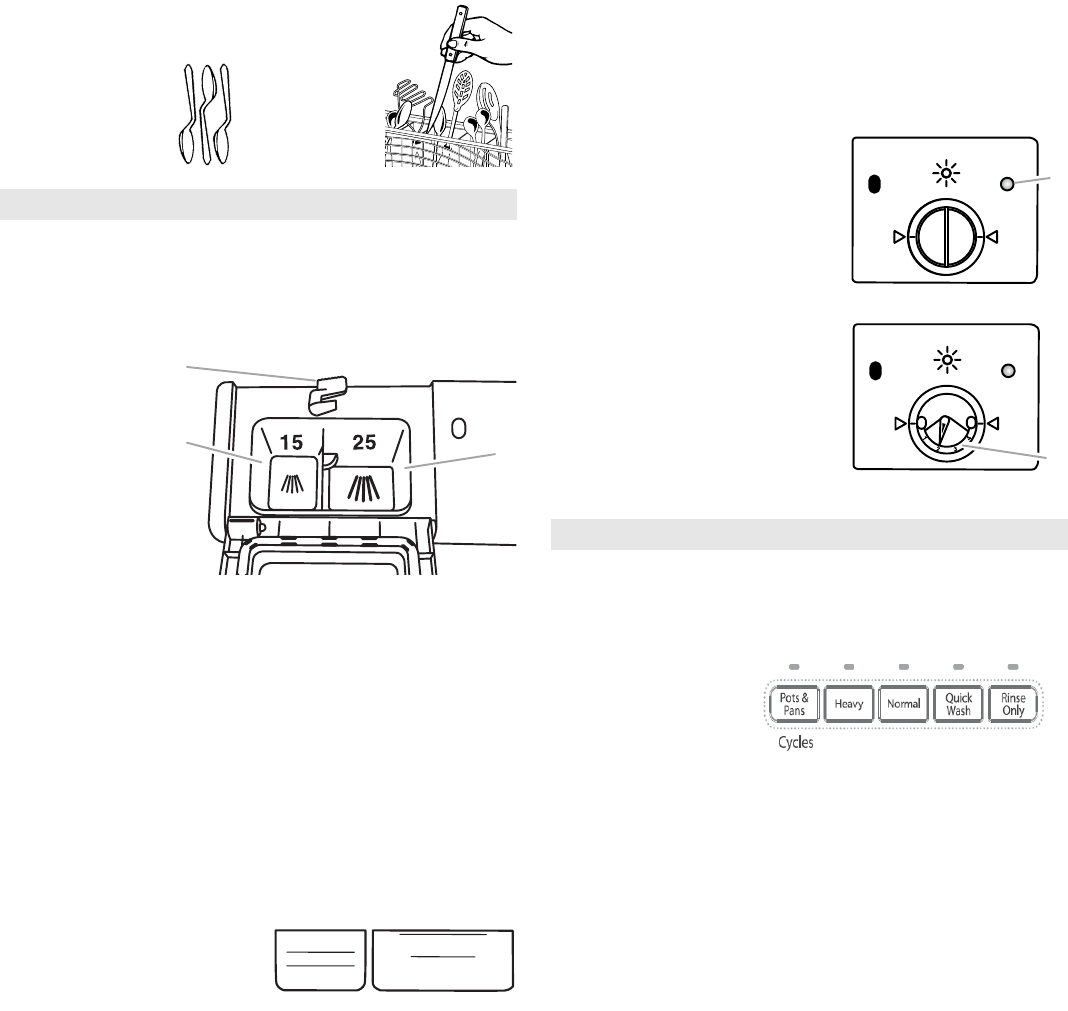
3
■ A
void overlapping items like bowls or plates that may trap food.
■
Place
plastics, small plates and glasses in the upper rack.
Wash only plastic items marked “dishwasher safe.”
■
T
o avoid thumping/clattering noises during operation, load
dishes so they do not touch one another. Make sure lightweight
load items are secured in the racks.
Add De
tergent
NOTE
: If you do not plan to run a wash cycle soon, run a rinse
cycle. Do not use detergent.
■ Use au
tomatic dishwashing detergent only. Add powder, liquid
or tablet detergent just before starting a cycle.
■ Fr
esh
automatic
dishwasher
detergent
results in better
cleaning. Store
tightly closed
detergent
container in a
cool, dry place.
■ Th
e amount of detergent to use depends on:
How much soil remains on the items - Heavily soiled loads
require more detergent.
The hardness of the water - If you use too little in hard water,
dishes won't be clean. If you use too much in soft water,
glassware will etch.
Soft to Medium Water (0-6 grains per U.S. gallon)
[typical water softener water and some city water]
Medium to Hard Water (7-12 grains per U.S. gallon)
[well water and some city water]
■ De
pending on your water hardness, fill the Main Wash section
of the dispenser as shown. Fill the Pre-Wash section to the
level shown, if needed.
NOTE: Fill amounts shown are for
standard powdered detergent.
Follow instructions on the
package when using other
dishwasher detergent.
Add Rinse Aid
■
Y
our dishwasher is designed to use rinse aid for good drying
performance. Without rinse aid your dishes and dishwasher
interior will have excessive moisture. The heat dry option will
not perform as well without rinse aid.
■ R
inse aid keeps water from forming droplets that can dry as
spots or streaks. They also improve drying by allowing water to
drain off of the dishes during the final rinse.
■ R
inse aid helps to reduce excess moisture on the dish racks
and interior of your dishwasher.
■ C
heck the rinse aid indicator. Add rinse aid when the indicator
window looks clear.
■ T
o add rinse aid, turn the
dispenser cap counterclockwise
and lift off. Pour rinse aid into the
opening until the indicator
window looks full. Replace the
dispenser cap and turn
clockwise. Make sure
cap is fully locked.
NOTE: For most water conditions,
the factory setting of 2 will give
good results. If you have hard water
or notice rings or spots, try a higher
setting. Turn the arrow adjuster
inside the dispenser by either using
your fingers or inserting a flat-blade
screwdriver into the center of the
arrow and turning.
Se
lect a Cycle
NOTE:
Heavier cycles and options affect cycle length.
Po
ts and Pans
–
U
se for heavily soiled,
hard-to-clean items.
H
eavy Wash
– Us
e
for heavy food soil.
Normal – U
se for
normal food soil. The
energy usage label is
based on this cycle.
Qu
ick Wash
– Use for prerinsed or lightly soiled loads.
Ri
nse Only
– (n
o options apply to this cycle) Do not use detergent.
A rinse keeps food from drying on your dishes and reduces odor
buildup in your dishwasher until you are ready to wash a full load.
Se
lect Options
■ A heated
dry option should be used for best drying of
dishes. When the heated dry option is selected, the
light is on.
■ A n
o heat dry option can be used to save energy.
■ Wh
en loading silverware, always place sharp
items pointing down and avoid “nesting” as
shown.
STEP 2
A
.Cover latch
B.Pre-Wash section
C.Main Wash section
B
A
C
Soft W
ater
Hard W
ater
Soft W
ater
Hard Water
Main W
ashPre-Wash
STEP
3
A.
Indicator
A
A
. Adjustable setting
A
















